
Developing a delightful, capable, and reliable software product is a team effort, usually made over a long period of time. Sometimes, it may take years to develop the perfect software. This is where knowing which of the software development lifecycle methodologies to adopt becomes critical to success.
What are the Software Development Methodologies?
The structured processes that govern the development of software right from the ideation stage to its delivery are called software development methodologies.
Without the right processes in place, completing a long-term project on time is an incredibly challenging task. This is especially true when multiple contributors and stakeholders are involved in the project, which is the case for most software development undertakings.
For this reason, having a well-defined system is vital for the success of software development teams.
Different teams working on different kinds of projects may encounter different sets of problems and challenges. This is why there is no one-size-fits-all software development methodology that guarantees success. Instead, the kind of technologies a team is working with, the intricacies of the project, and the size of the team can influence the choice of a software development methodology.
Software development methodologies have moved from an attitude of code & fix to modern methods that have made planning as well as a discipline a routine.
Typically, software teams have 15 choices when choosing between different software development lifecycle methodologies.
Top 15 Software Development Methodologies List
We would like to list down all the 15 software development methodologies we will be covering in this blog, The methodologies discussed below, are not presented in any particular order.
- Big Bang Model Methodology
- Prototype Model Methodology
- Waterfall Model Methodology
- Agile Software Development Methodology
- Rapid Application Development (RAD) Methodology
- Dynamic Systems Development Model Methodology
- Spiral Model Methodology
- Extreme Programming Methodology
- Feature Driven Development (FDD) Methodology
- Joint Application Development (JAD) Methodology
- Lean Development Methodology
- Rational Unified Process Methodology
- Scrum Methodology
- V-Shaped Model Methodology
- Iterative Model Methodology
In this article, all fifteen will be discussed in detail. The objective is to help build a better understanding of the advantages and disadvantages associated with different software development lifecycle methodologies.
Let’s begin:
1. Big Bang Model Methodology
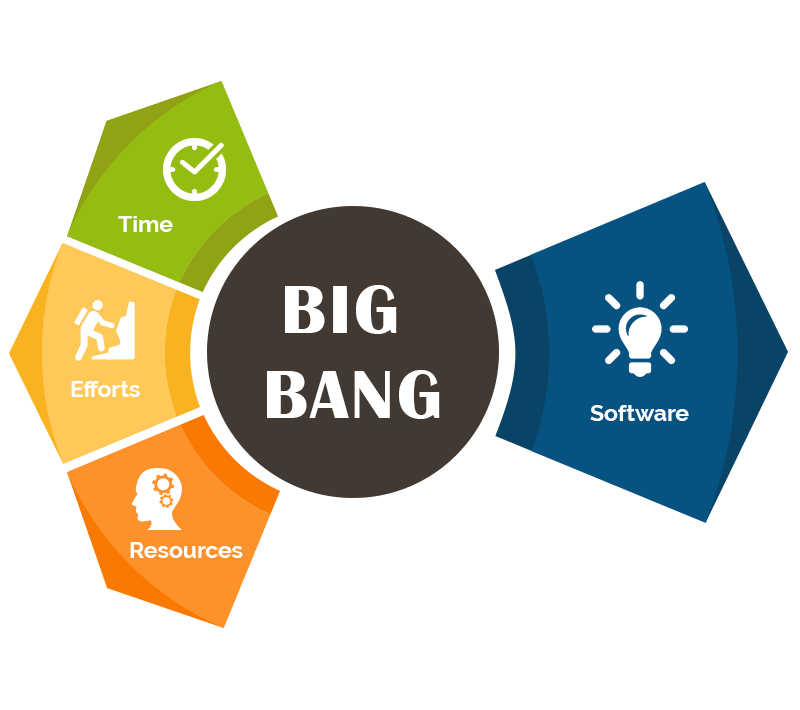
This model does not follow any trend in software development and this is usually implemented when the client is not aware of what his requirements are or how they should shape up. The Big Bang Model is used for smaller projects. This is a very simple model and no formal procedures are employed in the development process.
Advantages of Big Bang Model
- The model is an extremely simple one.
- There is very little pre-planning that is required and at times the development commences without any planning.
- The resources required are very few.
- It is very easy to manage.
- Using this model gives adequate exposure to beginners looking to develop their skills.
Disadvantages of Big Bang Model
- This is a high-risk model and this is why it is not recommended for complex and large projects.
- If the client’s requirements are not understood then the project faces the risk of being scrapped and restarted.
2. Prototype Model Methodology
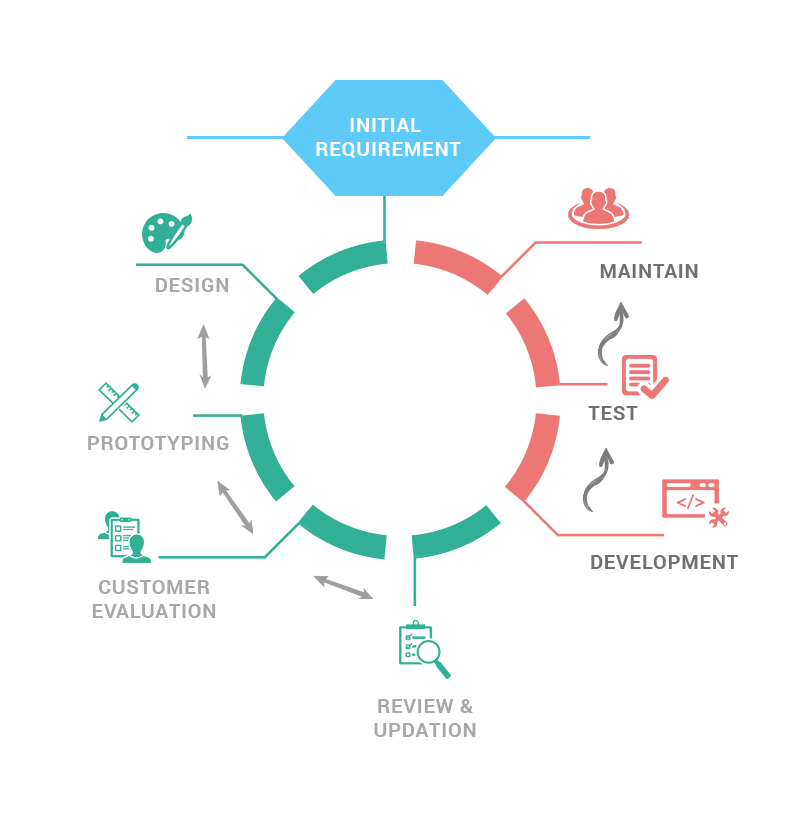
Software development means that there are processes involved in the creation of a program until its release and maintenance stages. Understanding the requirements of the software and conducting relevant market research aid in the creation of a prototype of the software.
As the name suggests, teams that employ the Prototype development approach first roll out a prototype of the actual finished product to the users. Then, feedback is collected.
Based on the collected feedback, interactions are introduced to the product till the point where the users find it satisfactory. This continuous evaluation and improvement of the prototype lead to the development of a flawless finished product. At the same time, excessive iterations can lead to delays in the delivery of the project.
The key to achieving success with this development methodology lies in the effective communication between the developers and the users (testers). The Prototype development approach works best for projects where there are many unknown variables at work, like online platforms meant for a large number of users.
This prototype then undergoes a development process. This kind of software development methodology allows developers to create a prototype of the solution that they visualize so that the clients can see how it will run. Any modification can be added before the actual software is developed.
A typical prototype methodology flows in the following way – the requirements create a prototype/design concept and is shown to the client for an evaluation and review, then the updates and changes if any are addressed before the actual development process and test phases and finally, the maintenance stage is reached. As an example, Structural engineers can, with the assistance of prototypes, create a new design and then conduct tests on it to understand the design’s resilience to vibration, noise, etc. A prototype model can help to catch problems that one cannot avoid in a waterfall-type model.
Advantages of Prototype Model
- Clients find it easier to understand the design of the software with a prototype model. The way the software will ultimately function is better felt with this methodology.
- The development experts who are working on the prototype can also gauge if the software is able to match up to the client’s expectations and make changes accordingly.
- Risk factors are easily identified very early on and steps to correct these errors are also possible with the prototype model.
- Another benefit is that the designers are able to get important feedback earlier in the development cycle from testers. This saves on unnecessary expenses post-launch.
- Real-time tests and constant interaction between the client and the developer helps to forge a positive relationship between the two.
Disadvantages of Prototype Model
- It is the developing agency that bears the cost of the prototype model so costing must be considered at every stage to reduce waste of resources.
- Not every software developer likes constant changes that a client can insist on.
- Repeated changes and risk analysis that cause too many design changes can be detrimental to the workflow process and can be very distracting.
3. Waterfall Model Methodology
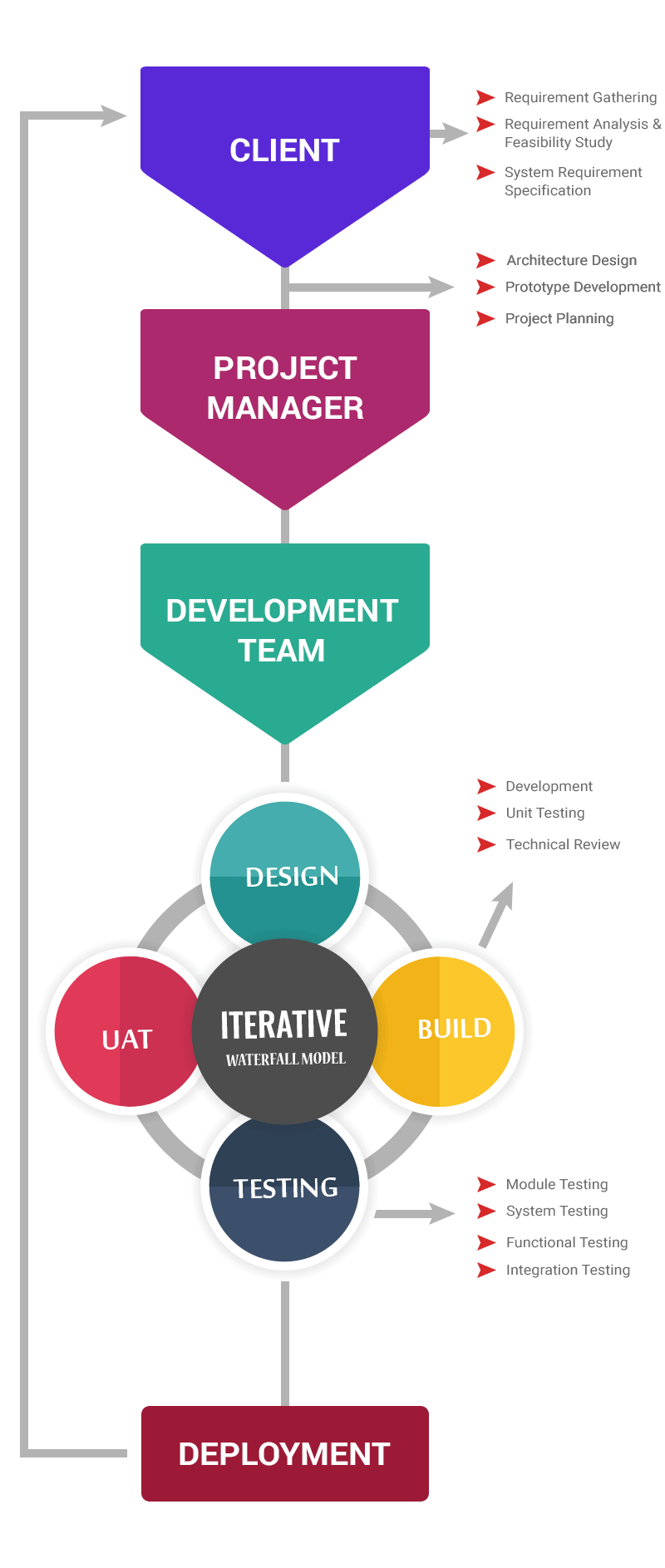
This model is traditional and is also used commonly. It is also referred to as the traditional/conventional approach and is more of a classical form of the process of software development. When one conducts a software development methodologies comparison, it becomes clear that the Waterfall development methodology is one of the simplest ones. The methodology approaches the different stages of the development process in a linear, sequential manner.
The Waterfall model uses an approach that has 5 sequential and important stages of SDLC. These stages include
- Client requirement gathering
- Design sampling
- Implementation
- Testing
- Maintenance
The linear sequential flow in the Waterfall model means that the next stage in the development process commences only if the previous stage/process is completed and definitely involves detailed documentation and verification of all the requirements. There is no set method to return to the earlier phase in case there are changes in the requirements. This model is also known as a heavyweight methodology as the processes are long and are quite inflexible. Waterfall Model is not very accepting of change but it does have some unique features as listed below.
Only once a step has been completed can the developers start working on the next step. Most Waterfall processes are implemented in a manner that once a step is completed, there is no turning back.
This makes the Waterfall development methodology inflexible and, thus, not suitable for projects that have evolving requirements. Instead, it is the ideal choice for inexperienced teams that are working on clearly defined projects with a clear end product as their objective.
Advantages of Waterfall Model
- The waterfall model can be implemented for projects of all sizes.
- Testing is an inherent part of every stage of this model.
- This kind of software development offers a clear and concrete approach.
- Documentation for every stage is maintained by the developers making it easy to map trails.
- This model of software development is simple and easy to work with making it a popular choice among amateur developers.
- This is a rigid model yet this works in its favor as it is this rigidity that makes it that much easier to manage. Smaller projects benefit from the Waterfall model as the requirements are easier to understand.
- The Waterfall Model ensures that the processes are completed in stages and this is a time-saving factor.
Disadvantages of Waterfall Model
- The Waterfall Model is of no use for any maintenance-related project and is ideal for long-term projects.
- As mentioned in the summary, editing a process once it is in the testing phase is not possible.
- The Waterfall Model works best when the requirements are clear-cut and precise.
4. Agile Software Development Methodology
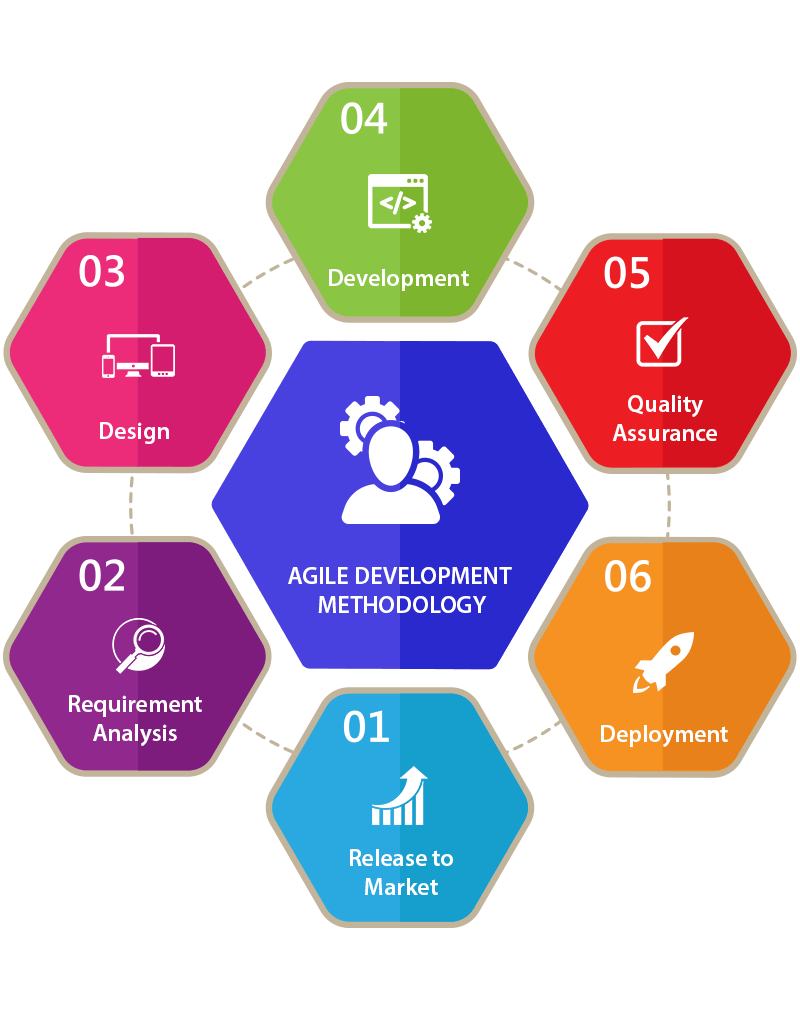
Agile is perhaps the most well-known on this software development methodologies list, and for a good reason. As the name suggests, Agile methodology offers incredible adaptability and flexibility, both extremely valuable qualities for the success of development projects.
Teams that employ the Agile methodology divide long tasks into smaller “sprints” that can be completed within about one to four weeks. As the development progresses, teams using the Agile methodology also conduct tests consistently to identify necessary iterations.
Agile methodology puts the end-user at the heart of the process. Developers continually take feedback from customers to improve the end product during the different stages of development. This makes Agile a perfect choice for teams developing a product for a new, unexplored niche.
With that said, there are a few limitations of the Agile methodology as well. The change requests and testing can potentially overwhelm small teams, and discussions dedicated to collecting feedback can also be time-consuming. Documentation is also not a priority for teams that employ the Agile methodology. Lack of properly structured documentation can give rise to challenges in the later stages of development.
Your project requires you to be flexible and be able to make changes in order to be successful in a turbulent and unforeseen environment. That’s where Agile comes into the picture. Agile is one of the most widely used software development methodologies. It is an umbrella term that encompasses a range of different methods and practices. These methods are based on the values as well as principles that are expressed in the Agile manifesto. Solutions are expected to evolve as cross-functional teams make use of various required practices for the need of the project during the software development life cycle. That leads to prompt as well as flexible responses to change in the process of software development.
Advantages of Agile Software Development Methodology
- Changes – Agile understands and acknowledges that things will change. However, such changes don’t really disrupt a project. They are in fact turned into a positive not only for the project’s outcome but also for the team involved.
- Creative Options – Agile Software development allows improvements and modifications during the development process and this allows developers to be creative with their design codes.
- Costing and Budgets – The Agile software development process requires a project cost to be estimated at the start of the iteration. This helps the team to understand where to expend resources correctly during the development process.
- High-Quality Output – Agile Software Development processes deliver a superior quality product as the processes are divided into smaller parts which in turn make it easier to test and to maintain. This reduces errors and improves the quality of the end product.
- Clear Communication – Regular and transparent interaction between the client, the developers, and other members of the design process helps to ensure that the project being developed has focus as well as clarity.
Disadvantages of Agile Software Development Methodology
- There could be issues regarding the clarity of the project if the client is not very sure of how he wants the end result to flow. This in turn will adversely affect everything, from the design process to the budget of the project.
- Agile Software technology focuses more on functional software and does not put any emphasis on paperwork. A lack of basic documentation could be a drawback for the design process, especially for references.
- Many traditionalists criticize Agile Software Technology for its non-restrictive method of working and claim that it lacks the support of a solid structure.
5. Rapid Application Development (RAD) Methodology
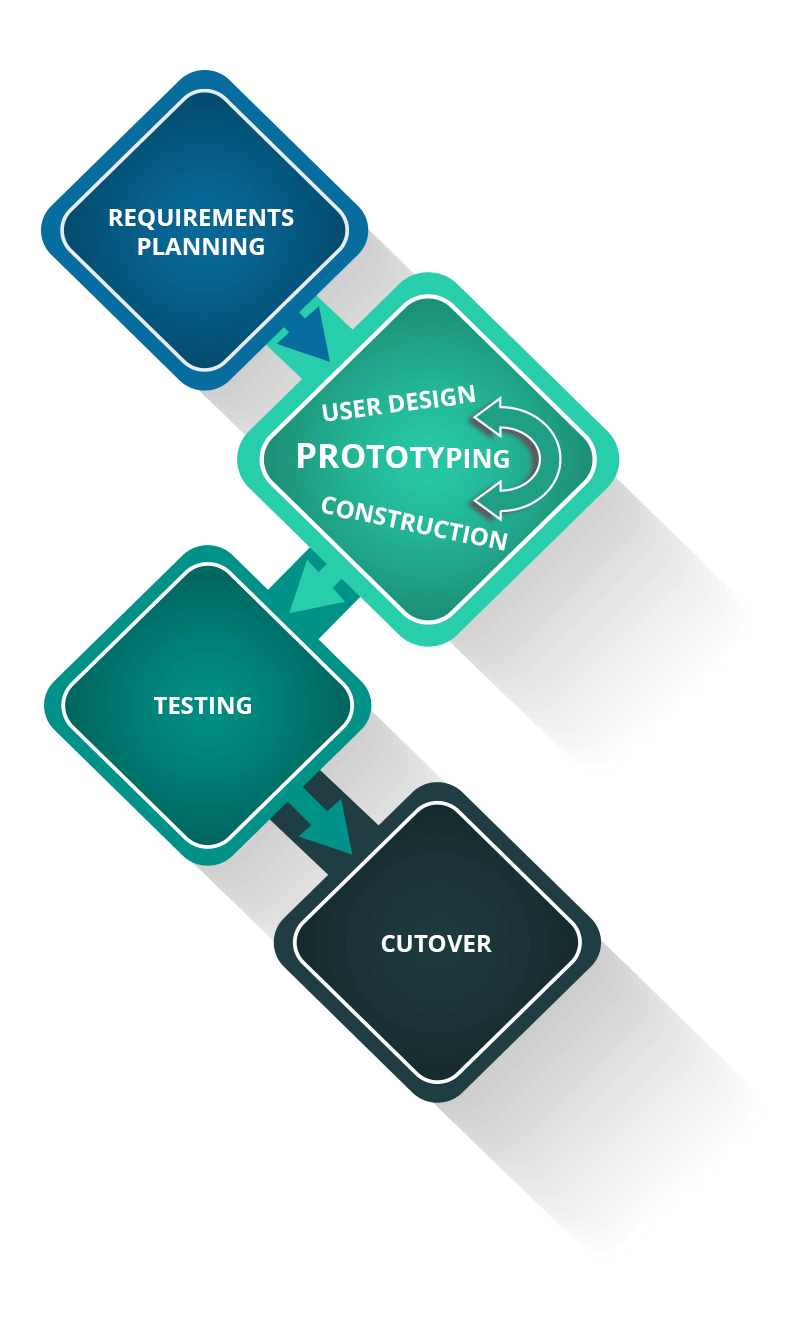
The Rapid Application Development methodology is a way towards faster processing of software. This is achieved by developing functions parallel and then integrating them into a working prototype. This SDLC method promises results of higher quality along with much quicker results which is why it is known as Rapid Application Development. With clients and end-users actively taking part in the development process makes this a very user-friendly development process. Any risks that development in the process can be dealt with and even changes in the customer’s requirements can be incorporated easily. Developers can easily put checks in place to prevent any major problem in the software creation process and this process also requires and encourages clients and other users for their feedback.
Advantages of Rapid Application Development Methodology
- All software development processes always benefit from their client’s feedback and this helps to maintain and improve standards wherever required.
- The RAD model reduces the risks of errors during the development process as functions are worked on separately and then integrated.
- Regular tests conducted during the RAD process also eliminate the chances of expensive errors.
- The client is able to review the development process regularly; this allows changes to be added to the software as and when required.
Disadvantages of Rapid Application Development Methodology
- The major disadvantage in this process is that this method is not practical for projects on a small budget. The costs involved in automated code generation do not fit into smaller budgets and the cost of modeling is also quite high.
- The RAD process is very dependent on a strong professional team with experienced individuals to understand and identify the client’s requirements and to create them.
- All organizations will not be able to afford a team of designers and skilled professional developers as these come with high costs.
- Only those systems and designs that one can slot into modules can benefit from the Rapid Application Development process and this is not practical for all kinds of software development.
Also read our post on Software Development Outsourcing
6. Dynamic Systems Development Model Methodology

This methodology of software development is part of the Agile Development methodologies where each individual methodology has its own principles and a unique approach.
The Dynamic Systems development methodology is a result of the evolution of software development methodologies. The methodology builds on and improves an old development methodology known as Rapid Application Development.
The Dynamic Systems Development methodology involves four steps:
- Feasibility and business alignment study
- Creation of a functional model
- Designing and building
- Implementation
Like its predecessor, the Dynamic Systems Development methodology is heavily dependent on efficient and insightful user feedback to enable the creation of a delightful software product.
This methodology is ideal for big organizations and teams that struggle with productivity challenges. Implementation of the Dynamic Systems development methodology can potentially streamline the development process by enabling progressive iterations and effective communication.
These also have similar features to each other like goal orientation, lightness, flexibility, and a focus on continuous development. The DSDM methodology is based on the RAD model and encourages involvement by the user. Among its goals is to develop and provide software models within the specified budget and within the deadlines. The thought that governs Dynamics Systems Development Methodology is that software development is a constantly changing process as it needs more than one attempt to gain success.
Advantages of Dynamic Systems Development Model
- The end users are usually more involved in the process of software development in this methodology and therefore are better able to understand the functions of the system.
- With the help of Dynamic Systems Development Methodology, the basic functions are easily developed first and more complex or advanced functions are constantly being developed and added to the software.
- Projects using Dynamic Systems Development Methodology are able to limit themselves to the budget on hand and are able to fit the timelines as well.
- Developers and end-users both find this methodology easy to use as well as to access.
Disadvantages of Dynamic Systems Development Model
- The main disadvantage of the Dynamic Systems Development Model is that it is too expensive to implement mainly as both the users as well as the developers have to have the required expertise in order to benefit from the methodology.
- This is not suitable for businesses with a small budget as well as for those developing one-time projects.
- As it is a new methodology its use is not common and there are not many experts available who can get the best out of this model.
7. Spiral Model Methodology
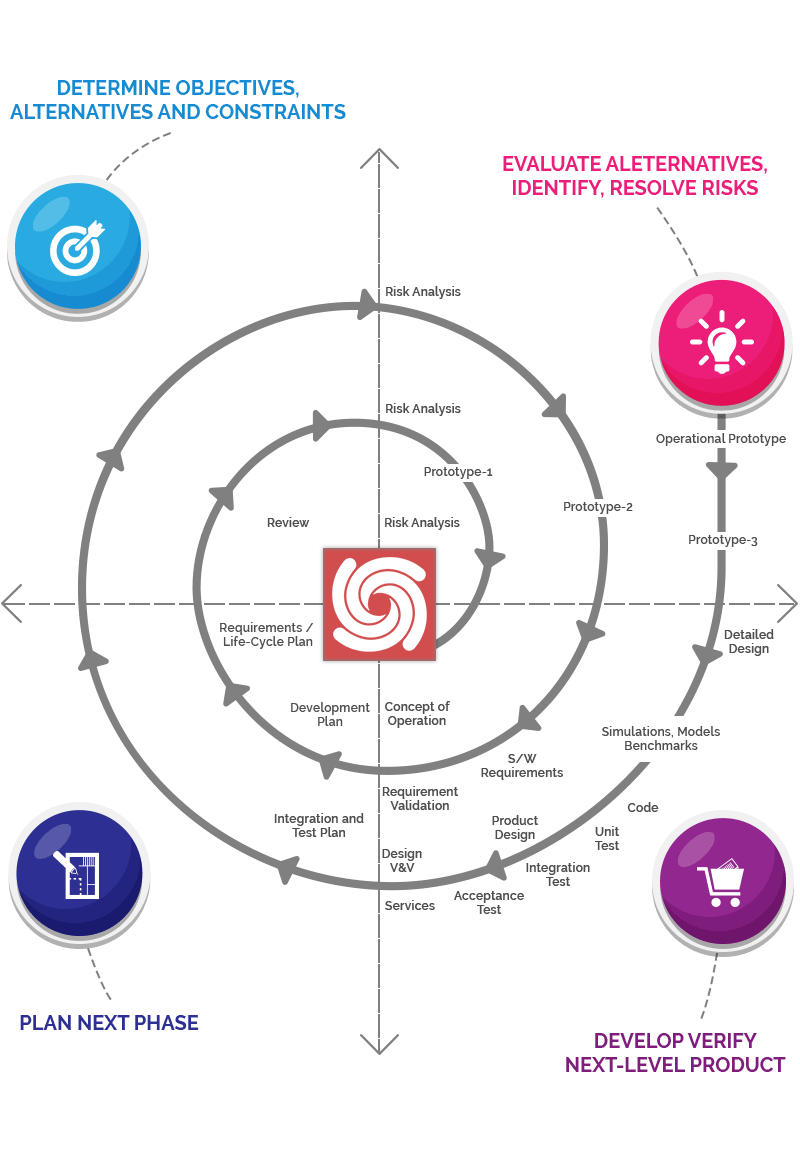
Developing software is similar to converting a creative concept into a functional and practical system. Unlike a waterfall model, a spiral method allows the developer to make changes in the code or in the design even in the testing phase. The Spiral Methodology moves in a loop that is circular, checking the phases of the design until the developer is satisfied. Alterations if any are made and quality checks are performed side by side. With the Spiral model, there is the assurance of early detection of risks to the project with steps to reduce them. With the Spiral method of software development, a developer will start on a small scale, estimate the risks then find ways to eliminate these risks before deciding whether the project is feasible to continue. Good management is very important to the Spiral Method.
Advantages of Spiral Model
- Risk factors are reduced as there is it involves extensive Risk Analysis.
- This is an excellent method to use while developing software for important projects and for large projects.
- Additional features and functions can be easily added even as late as the testing phase.
- High-Risk projects have benefited from this methodology especially as the requirements of the business can be subject to change and these changes can be made to the software with the Spiral Method.
- The Spiral Method requires the cycles to return to the earlier phases repeatedly thus allowing changes to be factored in.
Disadvantages of Spiral Model
- This is not always a very cost-effective model for software development and has been known to be expensive at times.
- The risk analysis that is done affects the actual success of the model; if the risk analysis is faulty then the entire software project can be negatively affected.
- There is also a risk that the development might keep working in a spiral manner without coming to a conclusion.
- This is not a beneficial method for projects with low-risk factors.
8. Extreme Programming Methodology
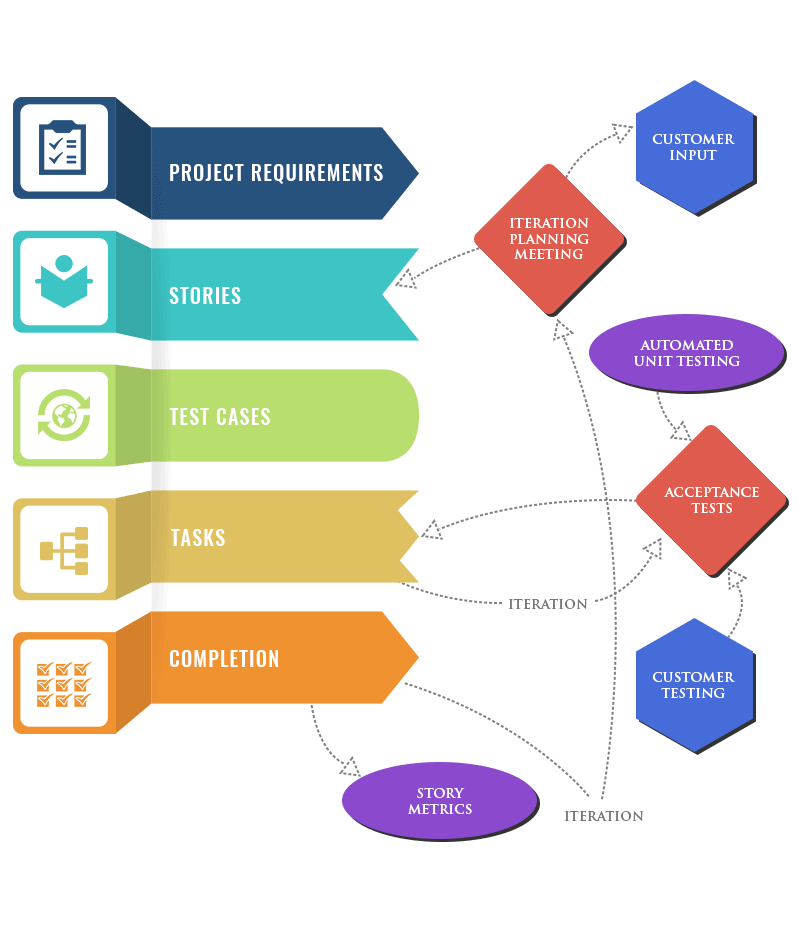
This is a flexible method that allows changes to be made with changes in requirements. This methodology is based on 4 main activities which are Coding, Testing, Listening, and Designing. All these meet together to create software that benefits the client’s requirements. Extreme Programming is best when software is required to be created within an unstable environment. Software developers working with XP Methodology during SDLC are able to deliver in shorter time frames than most other methodologies. XP Methodology also encourages feedback from their clients and this feedback is collated by testing the system and from inputs by other developers working on the same project as well as from the client directly.
Advantages of Extreme Programming Methodology
- XP Methodology’s goal is to lower the costs involved in software development.
- Customer involvement is considered important to the success of the XP Method.
- The XP Model puts emphasis on practical plans as well as schedules.
- There is a streamlined process of how developers commit their time to the project.
- The XP model is in line with the best current development methods and therefore developers are able to create software that meets all the standards.
Disadvantages of Extreme Programming Methodology
- The cost of changing the initial requirements at a later stage with the XP Model can be very high.
- The success of the XP Methodology is very dependent on the people involved in it, the more committed and clearer the vision, the better the end result.
- Using XP requires the various levels of people involved to meet and review often, this does prove to be a drain on the budget.
- Regular Development changes can be difficult for an average developer to handle.
- Providing a realistic quote is another stumbling block as the effort required and the project requirements are difficult to estimate at the beginning of the project.
WeblineIndia is one of the best Offshore IT outsourcing companies in India offering Custom Software development services. Reduce your cost up to 40% by outsourcing software development services to us.
9. Feature Driven Development (FDD) Methodology
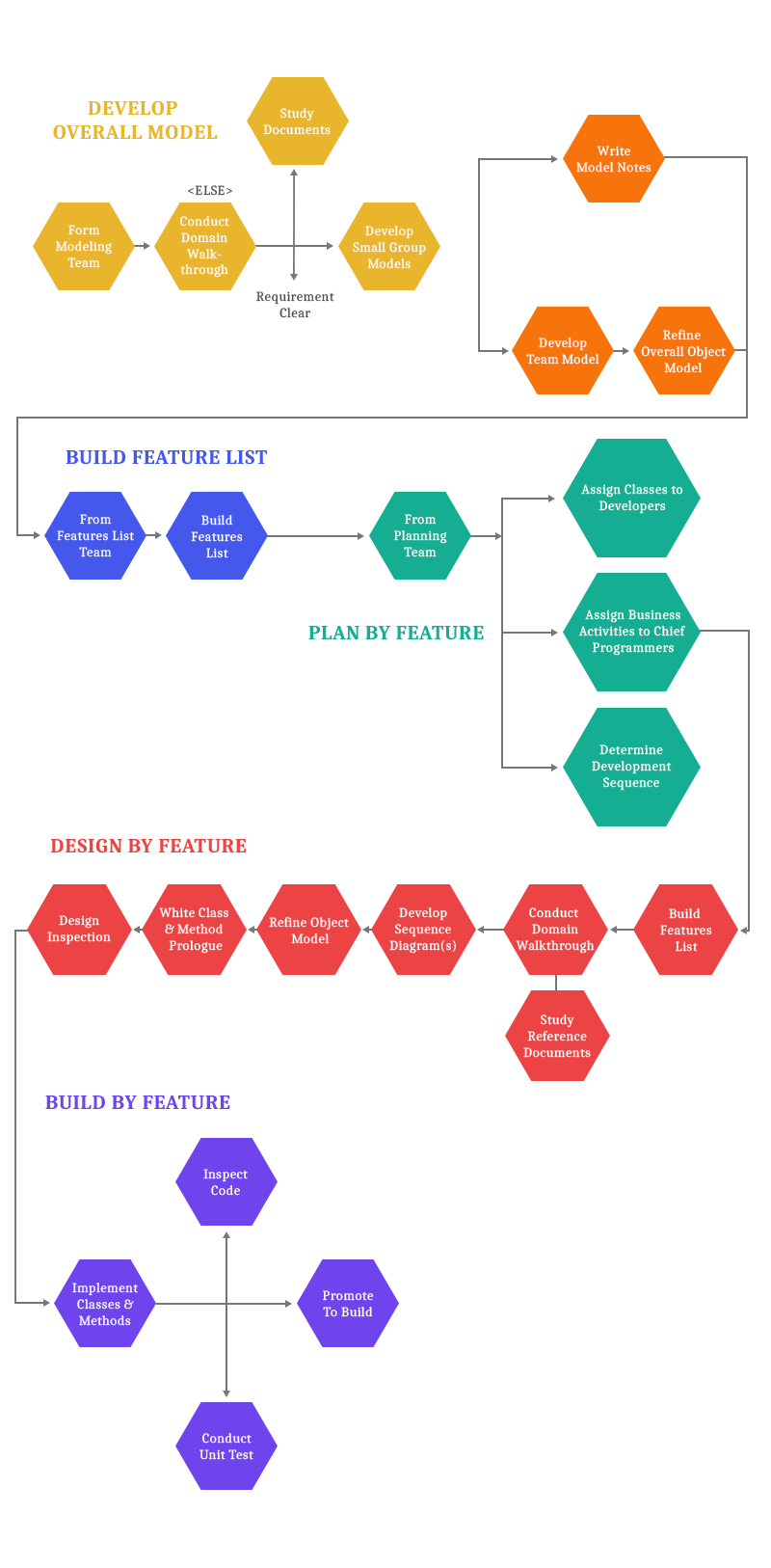
With the implementation of the FDD methodology, the development process is broken down on the basis of the different features needed for the final product. Then, development teams plan, design, build and optimize each feature based on feedback from users. Typically, the entire process that goes into developing a feature is completed within a span of two weeks.
As a result, teams that employ FDD are able to roll out great products in relatively shorter time spans while maintaining detailed documentation of the process.
This kind of software development uses the repetitive method also known as an iterative method along with object-based technology. This has found favor with larger teams of developers who work on projects that are progressing from working in phases to this iterative approach. An FDD model works by tracking the milestones that are kept for every stage of the progress in the software development with its 5 simple processes and these are
- Developing the complete model
- Building the list of features
- Planning
- Designing
- Developing by feature
FDD starts with a review of the scope of the system before domain models are created in great detail for each feature and reviewed again. The selected domain models are then merged into an overall single model.
The FDD methodology is best suited to large teams that are developing complex products and depends heavily on the management ability of the lead developer for success.
Advantages of Feature Driven Development Methodology
- This Methodology is able to move larger projects easily with a large degree of success.
- FDD’s 5 point process (as mentioned above) helps to develop software easily with the least time taken.
- FDD follows the standards set by the software development industry and therefore incorporates the best practices of the industry.
Disadvantages of Feature Driven Development Methodology
- The effort taken for an FDD technology is not feasible for small projects.
- Individual software developers cannot work on such a complex pattern of development.
- The main developer holds the entire framework together and the success of this methodology depends on his skill as a lead designer, mentor, and even a coordinator.
- Clients are unable to get the software in writing from the developers thus preventing them from obtaining proof for their software.
10. Joint Application Development (JAD) Methodology
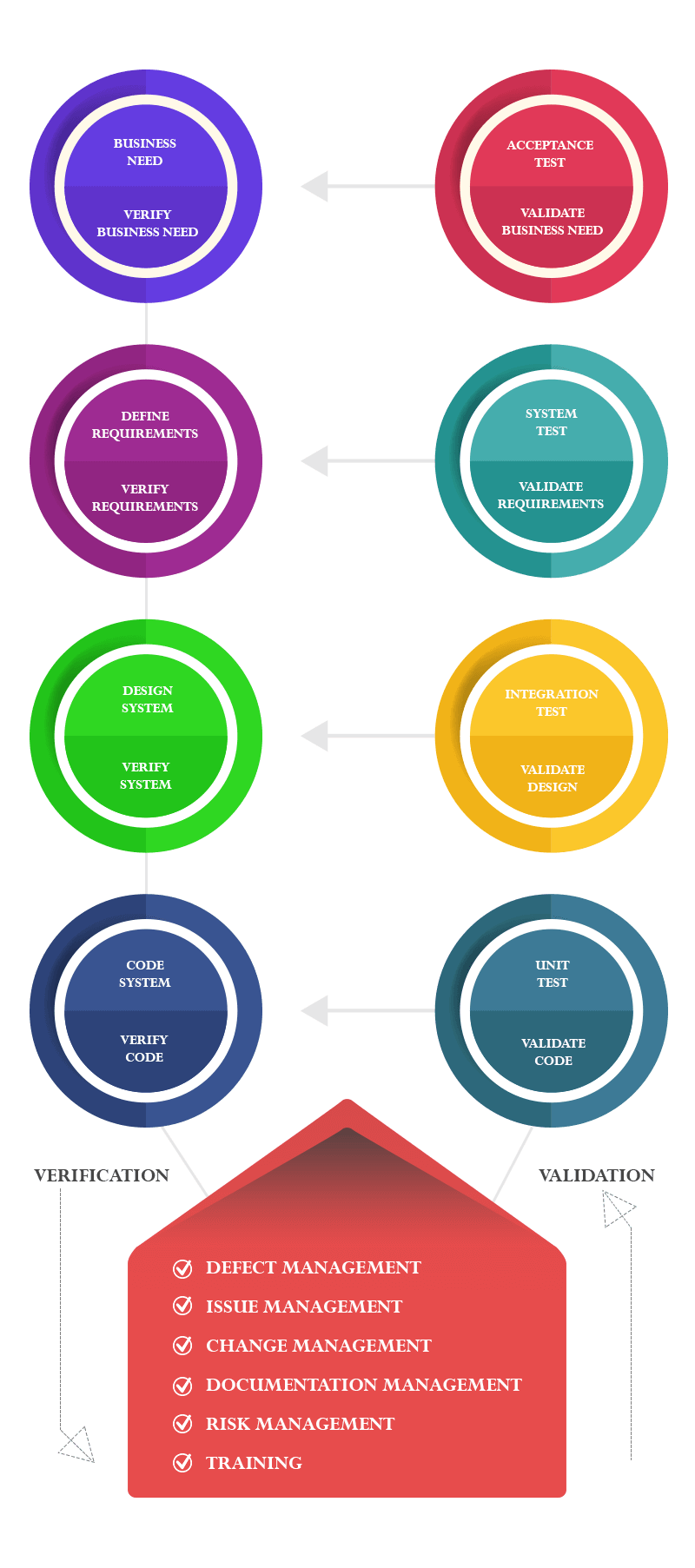
This methodology involves the end-user in the development and the design of the software development with the help of interactive workshops. These workshops are also known as JAD sessions. This is thought to have a higher customer satisfaction rate as the client is involved at every stage of the process of development. With its main focus on business solutions over technical ones, this is a popular methodology used for clients with growing businesses. This methodology was initially designed for computer-based systems but has been successfully used for all kinds of development processes.
Advantages of Joint Application Development Methodology
- With the help of the JAD sessions, users and developers involved in the model get to understand and to learn about various points of view related to software development.
- Large amounts of information are collated and researched simultaneously which adds to the experience.
- The JAD Methodology within a short time frame is able to produce high-quality information related to software development.
- An organizer plays a very important role in the JAD Methodology by solving all kinds of differences in the software creation process.
- The development process is faster with the JAD Methodology and the chances of errors are fewer.
- The end result with JAD Methodology is of high quality as the focus is always more on the up-front process of the development life-cycle which also reduces cost-inducing errors.
Disadvantages of Joint Application Development Methodology
- This process can be time-consuming as it requires a fair amount of scheduling and planning between the project development team.
- This is especially true of the JAD sessions as getting the project development team together at the same time is quite a task.
- Expectations from investors for their commitment are very high.
- Very experienced and trained individuals are required to see the project through.
11. Lean Development Methodology
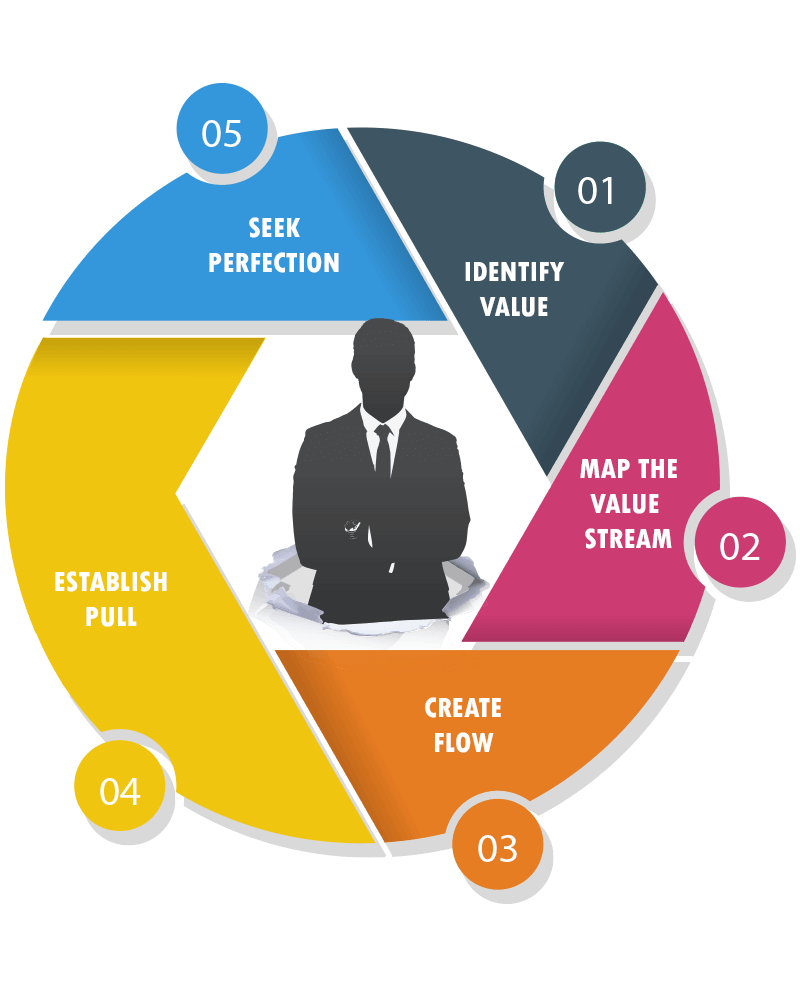
Inspired by the Lean manufacturing principles laid out by car manufacturer Toyota, the Lean development methodology reduces wastage while improving the productive output of development teams.
In most cases, the Lean methodology only works for teams that employ highly skilled developers that truly have what it takes to identify and eliminate the biggest bottlenecks. However, teams that are able to implement this methodology successfully can potentially reduce the time and the cost associated with the development project by eliminating all that adds no value to the development process. This could include meetings, documentation, etc, and emphasizes imbibing quality in the process.
Teams employing the Lean methodology are tasked with finding and eliminating bottlenecks. At the same time, developers must also identify the tasks that will have the most positive influence on the progress of the project.
The Lean development methodology is ideal for small but skilled teams working on small projects with tight deadlines.
Advantages of Lean Development Methodology
- Eliminating unnecessary processes improves the overall efficiency of the software development and helps to reduce errors which in turn speeds up the process.
- The Lean Methodology believes in empowering the team working on the process, this not only creates a better-motivated work environment but also helps to hone the decision-making ability of the team members.
- The Advantages of completing projects in less time mean more time to start on future projects.
- Taking less time to complete projects is also beneficial to meeting deadlines set by the clients.
- The lean method also reduces the need to keep going back to correct errors which wastes time and increases costs.
Disadvantages of Lean Development Methodology
- The success of the project is very dependent on the teamwork, the discipline between them, and how the workflows in between their individual skills.
- Decisions must be prompt and final; this is what makes the Lean Methodology stick to time frames and budgets.
- Flexibility must be supervised as too much flexibility can be a deterrent to the timely functioning of the team.
- The wrong business analyst will just confuse the documentation pertaining to the process so having the right analyst with ample industry experience is very important.
12. Rational Unified Process Methodology
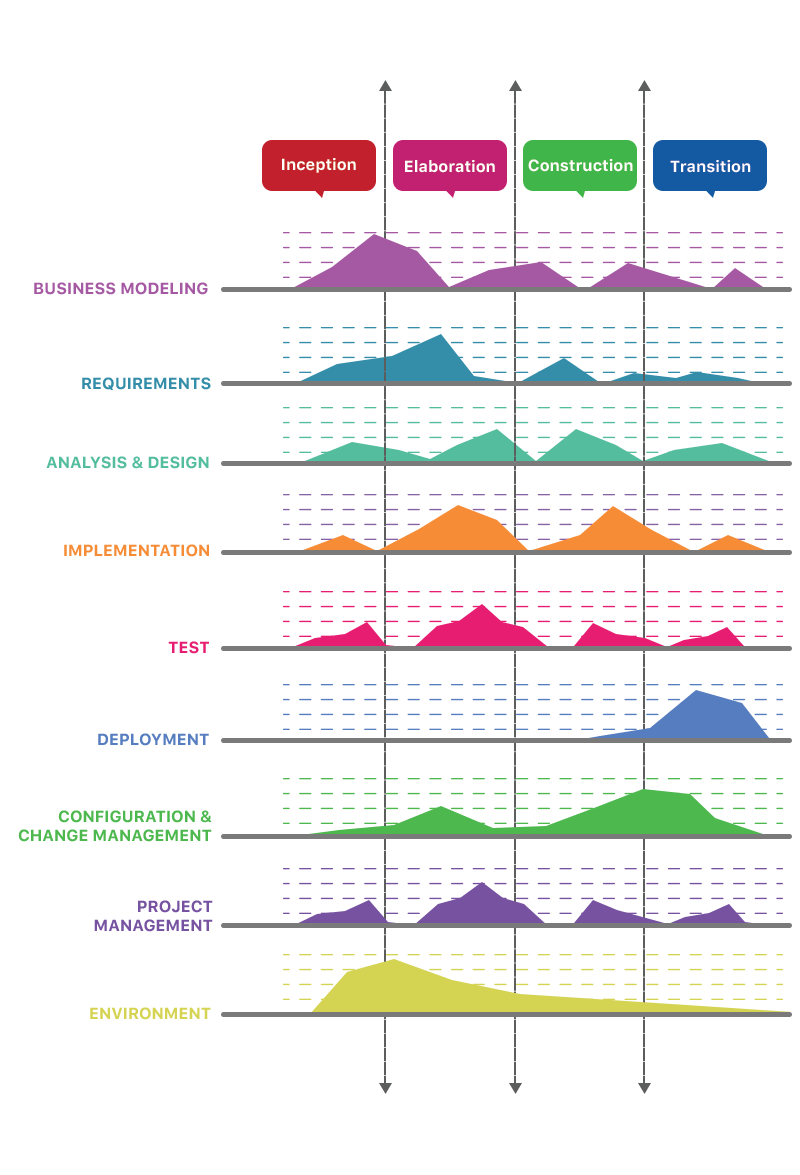
This Methodology works on the principle of dividing the process flow into 4 distinct parts. These are mainly Analysis and Design, Business Modelling, Deployment, Implementation, and Testing. The major difference between Rational Unified Process and the others is that the RUP provides its developers with tools like templates, guidelines, and step-by-step processes and examples for all the stages in the software development process. This process also continuously monitors the quality of the software being created and controls changes.
Advantages of Rational Unified Process Methodology
- There is an emphasis on the documentation that is correct.
- These processes are able to fix all the risks that occur when clients add or change their requirements with a process known as Change Request Management.
- Integration is a continuous process throughout the development so a separate time frame for integration is not required.
- Online tutorials and training are easily available for these processes.
- Components are reused so the development time naturally reduces.
Disadvantages of Rational Unified Process Methodology
- Untrained team members will be a disadvantage for this process and training them on the job will increase costs and add to the time factor negatively.
- All the stages in this methodology are not always organized and are at times complex.
- At times integration continuously during the process can cause confusion especially during the test phases; this is especially true for larger projects with multiple development streams.
- Reusing components is not always possible especially for those projects that are using the latest technology.
13. Scrum Methodology

The Scrum methodology is quite similar to the Agile methodology. Like Agile methodology, Scrum also enables quick, efficient, and continuous iterations to the product during the different phases of development. This allows teams to deliver flawless products in a short time period.
Unlike Agile, however, Scrum is dependent on a product owner, a Scrum Master, and a development team. The development team takes care of the actual development; the Scrum Master ensures everyone on the team is familiar with the Scrum process, and the product owner is responsible for communicating feedback and client needs to the team.
Implementation of the Scrum methodology also involves daily Scrum meetings that ensure that everyone in the team is on the same page and that the project is progressing as planned.
One of the most famous and widely used software development methodologies, Scrum, is a framework that makes use of the Agile software development methodology. This framework is flexible and encourages collaborative ways of managing a software project. One of the benefits of this method is that it allows you to move quickly and pivot easily when needed. Faster feedback cycles and the ability to recognize problems early have made Scrum one of the most popular methodologies around.
Advantages of Scrum Methodology
- Faster Feedback Cycle: There are times when you build exactly as per the requirement. However, that might still not suit the needs of the stakeholders. Scrum ensures that such problems are not recognized late. There is something actionable that can be presented at the end of the first sprint, which ensures that all stakeholders can be kept in the loop.
- Identify Problems Early: Scrum methodology focuses on keeping meetings brief and that lets the teams stay on track. This way, larger problems are identified with ease and can be taken offline without any time being wasted.
- Flexible Prioritization: Scrum offers flexibility in terms of prioritizing customer-driven features. With each sprint boundary, it becomes possible for you to more convincingly manage your shippable units of work and make overall progress towards a final product milestone.
Disadvantages of Scrum Methodology
- The time and cost estimates must be accurate, a careless estimate can adversely affect the project.
- This methodology is ideal for large projects but not so cost-effective for smaller projects.
- Coordination between the team members is very important for a smooth flow of the processes involved.
- Experienced and Qualified team members are a must in order to make the Scrum methodology successful.
14. V-Shaped Model Methodology
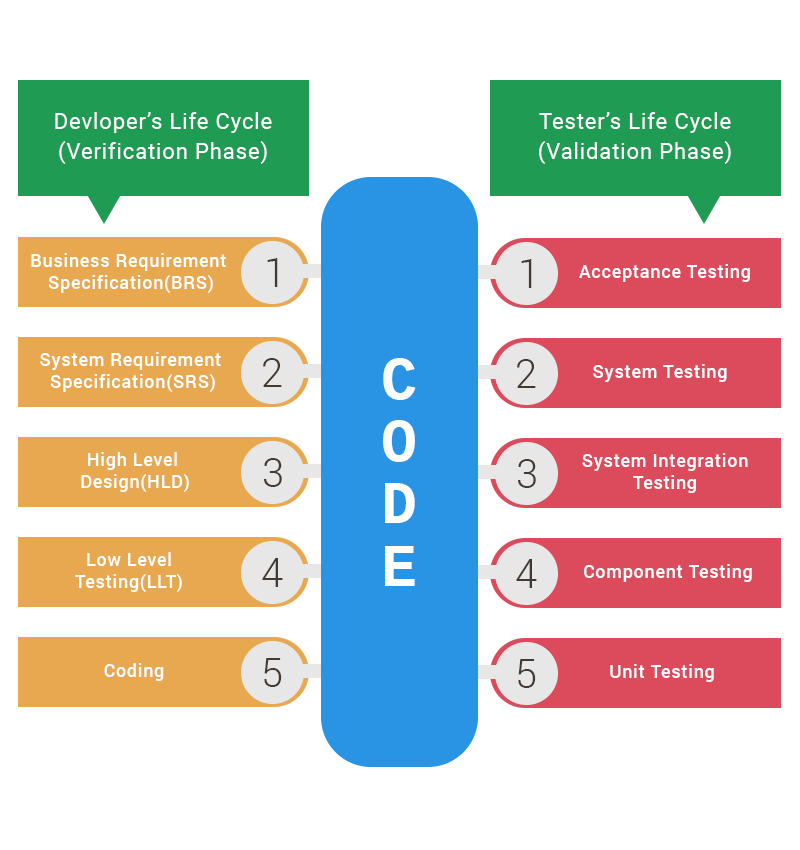
The processes that are a part of this methodology are in a V-shaped sequential manner. This process is also known as the Validation and Verification process. This is because there is a corresponding test phase for every stage of the development process. This methodology is ideal for projects that are small to medium-sized as the requirements are usually fixed. This also works best when technical resources are in plenty. There are basically 4 steps that are involved in the V Model and these are Unit Testing, Integration Testing, System Testing, and Acceptance testing. Each requirement and planning phase has a test phase running parallel to it.
Advantages of V-Shaped Model
- This Methodology is very simple to use and its ease makes it ideal for programmers to use.
- Before coding tests are conducted which include planning and design processes. This way errors are eliminated before the coding even starts.
- Errors are tracked even at the early stages preventing these mistakes from enlarging themselves at later stages in the code.
- The V-shaped Method does not allow defects to flow downwards and affect the progress of the software development.
- Ideal for small projects with limited and clear requirements.
Disadvantages of V-Shaped Model
- This Model is also known as the least flexible model and is also rigid.
- Prototypes or samples are not worked on as the software is created during the initial implementation stage.
- Trying to gauge errors at the beginning of the process could be time-consuming.
- An unplanned change during the development process will make it difficult for the test documents to reflect the same changes.
Read Post on White Label Software Development
15. Iterative Model Methodology
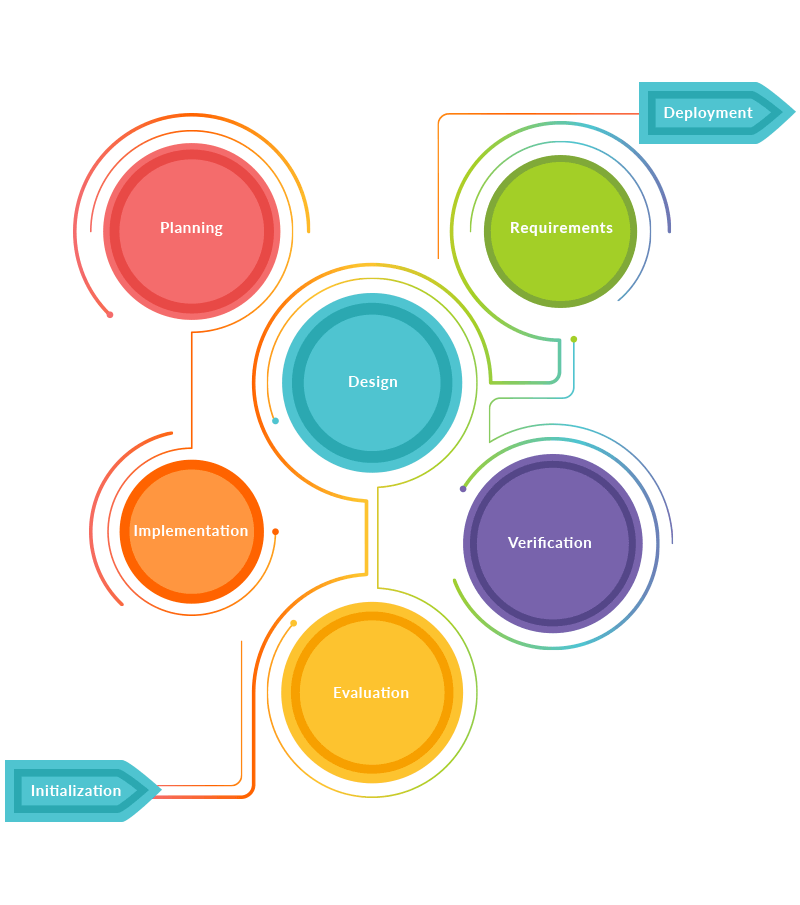
This model is different from the other as it does not start by specifying the requirements of the whole process but instead; just a part of the software is specified and implemented and this is reviewed before any further steps are taken. This Model breaks down the software development of a large requirement into smaller more manageable parts. The designing, development, and testing are done in a repetitive cycle. As this is repeated each and every cycle of the model gets a new software version produced. There is a working version that is ready quite at the beginning of the process that is tested; evaluated and further additional requirements are then identified.
Advantages of Iterative Model
- The main advantage of this model is that the process of system development is converted into smaller parts. When the system works correctly all the parts are then coordinated.
- The lessons learned from the errors that were eliminated from the smaller part can be used to develop the other parts of the process and this goes a long way to save on time and money.
- This Iterative method is also preferred as every permutation and combination need not be considered before starting work on the project.
- Solutions can be easily found as issues crop up by diverting back to the team who can work on solutions while the project development continues forward.
- A working model s available as a sample quite early in the development process and implementing changes is less inexpensive.
Disadvantages of Iterative Model
- The cyclic design of this model can cause it to go out of its budget as it can get into a repetitive mode.
- Time will need to be spent on closely monitoring deliverables and the time factor in order to live up to its cost-saving definition.
- There is no emphasis on maintaining documentation which can cause problems in the long term.
- There are no overlaps in an iterative model which makes it rigid.
Conclusion
These were the fifteen most popular development methodologies that top teams worldwide employ to build amazing products. As new and unique problems present themselves, new software development methodologies will continue to emerge. The key is to choose the right methodology that aligns with the business objectives and offers the processes needed to overcome unique business challenges.
Social Hashtags
#softwaredevelopment #softwaredevelopmentmethodologies #softwaremethodologies #softwaremethods #softwaredevelopmentlifecycle #bigbangmodelmethodology #prototypemodelmethodology #waterfallmodelmethodology #agilesoftwaredevelopmentmethodology #rapidapplicationdevelopmentmethodology
#dynamicsystemsdevelopmentmodelmethodology #spiralmodelmethodology #extremeprogrammingmethodology
#featuredrivendevelopmentmethodology #jointapplicationdevelopmentmethodology #leandevelopmentmethodology #rationalunifiedprocessmethodology #scrummethodology #vshapedmodelmethodology #iterativemodelmethodology
Testimonials: Hear It Straight From Our Customers
Our development processes delivers dynamic solutions to tackle business challenges, optimize costs, and drive digital transformation. Expert-backed solutions enhance client retention and online presence, with proven success stories highlighting real-world problem-solving through innovative applications. Our esteemed clients just experienced it.